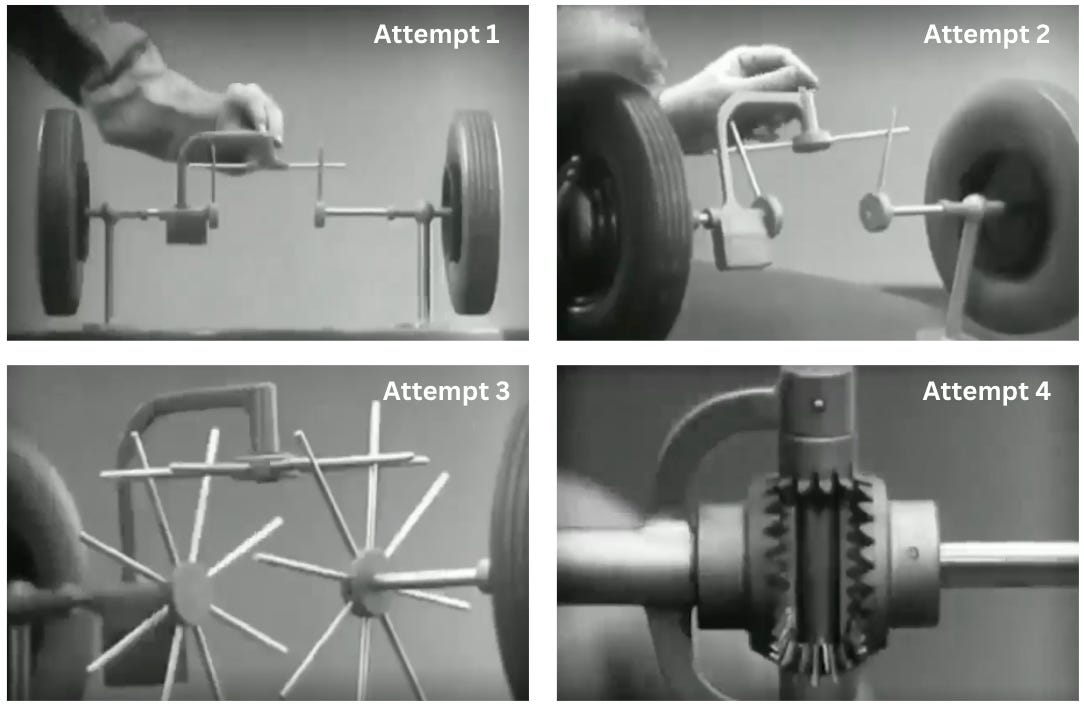Differential Mindset
What the axel of a car can teach us about independent thinking.
In todays episode of “what can I do besides what I am supposed to be doing” I came across a video detailing how the differential works in a car. Like most interesting but largely irrelevant videos in my feed I stopped to watch it (link here if you would like to as well- I highly recommend).
As someone who counts themselves as a generalist, much of our superpowers rely on abstracting concepts from completely unrelated topics and using them to build our skills in the current area of focus. It was a refreshing reminder that while outcomes matter, the process by which you arrive at them does too.
Are You Tracking?
For those unfamiliar with what a differential is you might be surprised to learn they are in every car, including yours. They were designed to solve a fairly straight forward physics problem- when you make a turn your outside wheel necessarily moves faster than your inside wheel.
If you don’t believe me go to your nearest high school track and run a lap on the inside most lane and the outside most lane - except you MUST record the exact same time for each lap. You will find you must run faster in the outside lane to record the same lap time that you did on the inside lane since it covers a greater distance.
Now imagine you have two wheels on that same track affixed to a single axel. When you hit the corners of the track the outside wheel must be free to accelerate to stay even with the inside wheel.
This is the problem a differential solves.
So why am I so hype for a 1937 video on car engineering? Well, mostly because it has a simplicity to it that I envy and find missing in the breakneck pace of todays world.
But also because there is much to learn from how the video clearly breaks down the dilemma and subsequently works through the solutions from the basic solve (we need wheels that can move independently) to the final product (a smooth and robust gearing so efficient no-one knows its there).
A transcript of the progressions would look something like this:
“How should we build a car axel?”
Attempt 1: Wheel on each side of a fixed rod - works on straight aways but is terrible on corners
Learning: we need the wheels to move independently of each other when turning
Attempt 2: Spoke on a pivot - this solves the problem of allowing independent movement, but provides a poor ride
Learning: we need smaller spaces between spokes so that there are less gaps between contact from the motor and the wheels
Attempt 3: Add more spokes - the more spokes, the more improved the ride, however it still remains choppy
Learning: no amount of spokes will be enough- we need something that always touches
Attempt 4: Replace spokes with gears that allow constant contact - this allows independent movement and an exceptional ride
Dare to be Different(ial)
This iterative process is critical not only when you are designing and building new products and processes, but also when you are learning existing ones. Why?
For one, when the next generation of engineers comes in if all they know are that cars work because they have differentials they lose valuable context and skill building that will help them to then tackle the next (yet unsolved) hurdle. You see this manifest in a couple of ways in organizations:
Massive bubbles: when no one truly understands what is going on “under the hood” issues compile without detection until they build into huge bubbles big enough to burst, and they inevitably do.
Inability to troubleshoot: not having a firm grasp of the underlying decisions, failures, and mechanics that went into a technology or data point make it near impossible to effectively troubleshoot when issues arise.
A second less explored consequence is that it diminishes the time and effort taken to arrive at the final product. When we reduce a complex process to only its end result it discourages those tackling the current problems by diminishing the actual work done. If you’ve ever looked at a product or solution and said “Jesus Christ whoever figured this out must have been a genius” you have felt this.
On the other hand it also creates unrealistic expectations by those overseeing the development of a solution. They internally ponder “I know Rome wasn’t built in a day but we already have a working model of X, why is it taking this person so long to deliver?”.
In a world that is so hungry for quick solutions, let us not forget that if we do not fully understand the core problem we wish to solve (why wheels need to spin at different speeds) or the iterative progress that has come before (why spokes failed) we are at best likely to spin our own wheels mired in confusion repeating past mistakes and at worst likely to build incomplete solutions.
So the next time you are tasked with solving or overseeing a complex problem take a differential mindset - even if if means moving independently from the organizations expectations.



